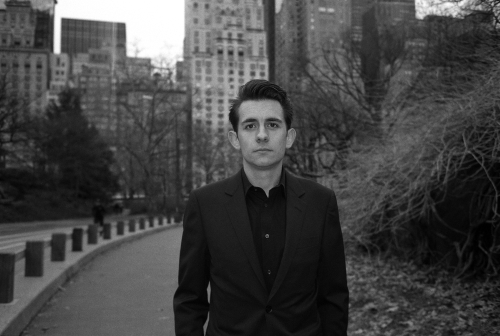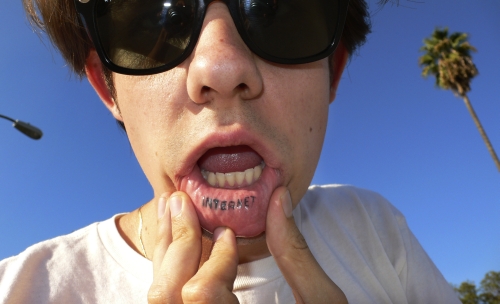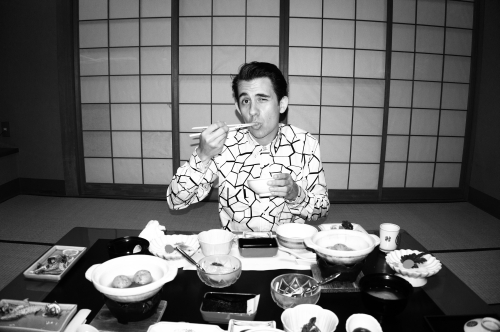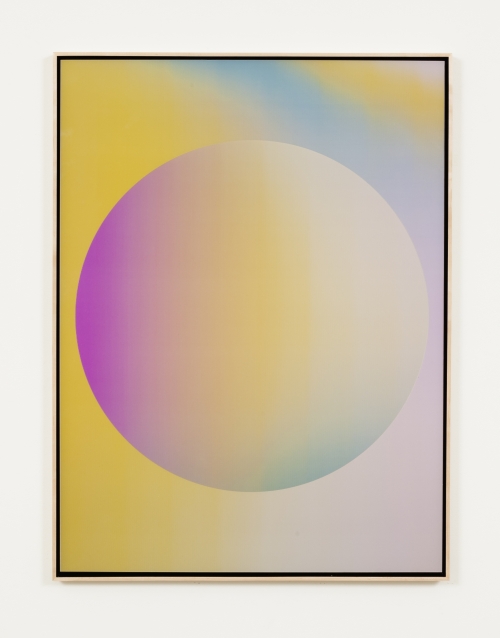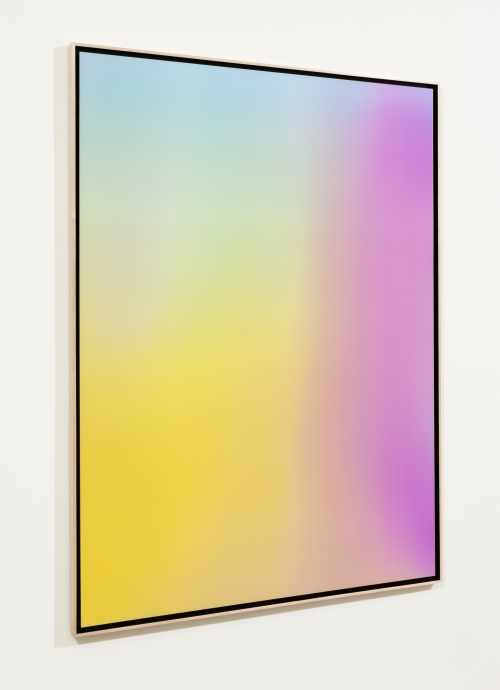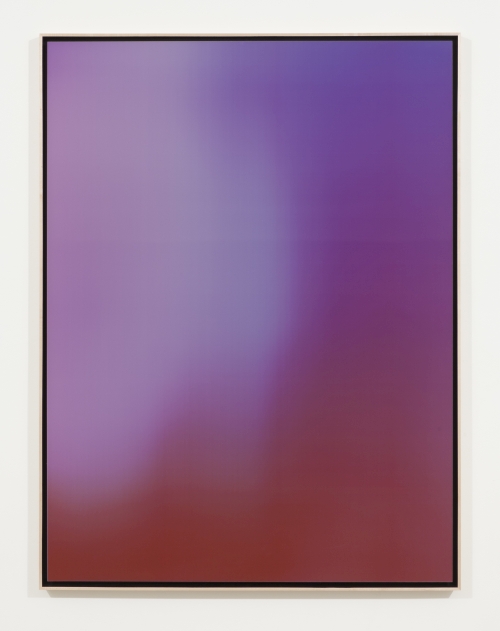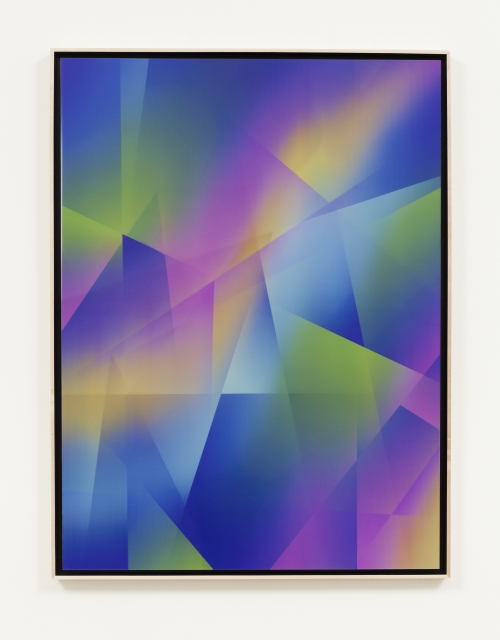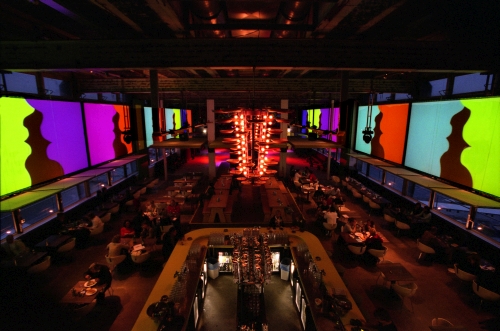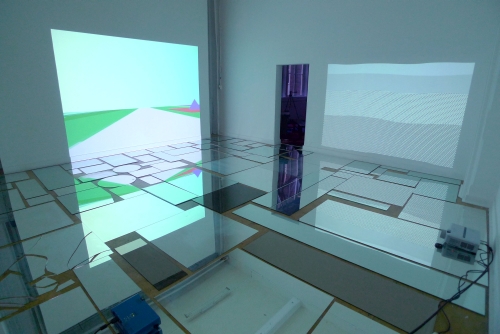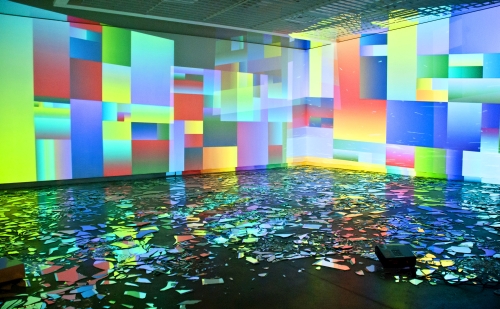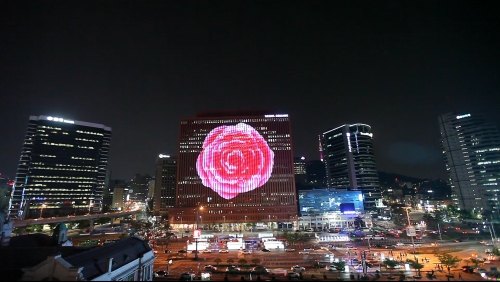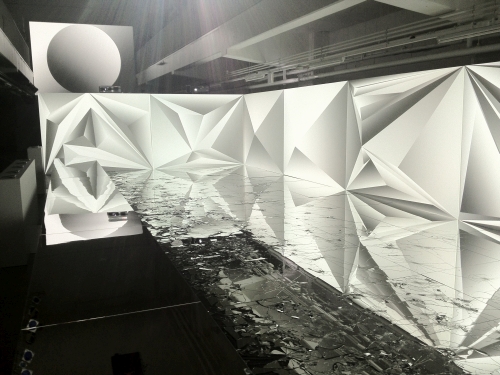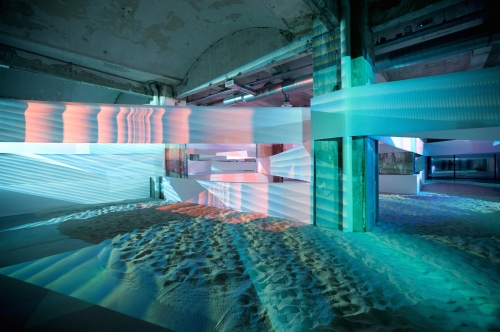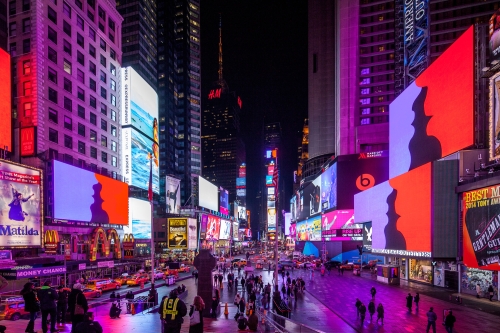

by A WILL BROWN
The work of Rafaël Rozendaal (b1980), a Dutch-Brazilian artist working in New York, takes shape as installations, websites, lectures, texts, projections and lenticular paintings. He is chiefly concerned with creating screen-based, readily accessible sculptures through creating and maintaining simple and functional websites, which currently number in the hundreds. For Rozendaal, the screen is a pictorial space, a canvas, on which he can recreate worldly experiences with bits, pixels and code. His web-based projects generate more than 30m unique views a year.
A Will Brown: When did you start making what you perceive as mature artwork, or art as a professional practice, and when did you start making art via the internet?
Rafaël Rozendaal: My professional practice began when I started making work for the internet in 2000/2001. I was 20 years old. Before that I did a lot of different things: comics, photographs, collages, movies, animations, drawings – always lots of drawings. I loved making things and it felt good, but I had not found something of my own. My first web piece felt different from the work I had made before. People responded strongly to it.I found an interesting path to explore. There was so much to be discovered because this new medium was asking a whole new set of questions about what art is and how we access it. This work is now in the collection of net-art pioneers Jodi, which I’m very proud of.
AWB: What were some of your earliest projects like?
RR: Like any child, I started with drawing. I think in lines. My parents are both artists so I was always exposed to materials and exhibitions. My early projects were all about having fun – funny drawings, funny videos, funny photographs. I always wanted to make funny work. I felt like the art world would not accept funny work, so the web was a safe place where I could really be myself.
AWB: I’ve listened to a few of your lectures, and am curious about the notion of uploading the mind. Can you expand on this? How does it play out now compared with in the past, and what about in the future?
RR: Humans are different from other animals because we can externalise our memory. We can store thoughts in various forms: words, images, sounds, movies. We can archive our thoughts and spread them. You can access other people’s thoughts and build on them. Whether this human “progress” makes life better is another question. But it is certain that humans want to learn and invent and, because we store our thoughts, each generation builds on the work of the previous one. In that sense, we have always been uploading our minds. The difference is that the distribution of information has been accelerated through network technology. This human expression, it’s not an exact copy of your interior, it’s another version of yourself that starts to live a life of its own.
I chose to make works specifically for the internet, the universal library, the place where all our thoughts will be stored. The more technology evolves, the more that less important thoughts are published. The universal library is not just filled with Nobel Prize winners, but everyday thoughts by everybody. It’s very honest about what is going on in our heads.
AWB: The idea that the people in your 2006 website muchbetterthanthis.com are always kissing, even when no one is looking at them is interesting to me. What about it, for you, is different from a painting, or a sculpture that lives in a museum or collection, but happens to not be on display?
RR: When I look at the distribution of art, it is interesting to compare it to the distribution of music. A masterpiece of visual art, such as the Mona Lisa, exists in one place only, behind safety glass, always surrounded by tourists. Masterpieces of music are easily accessible. You can listen to recordings and there are many concerts. It can become part of your life. You might listen to a song while you jog, while you are cooking, at a party, at a funeral, or in a stadium concert together with tens of thousands of people. A website is a work that exists in a specific place, in its domain name. It’s a place that you can go to wherever you are, by typing the title of the work into your browser. It’s a public place that is non-local. The website is a ubiquitous object, just like a musical recording. But it’s different from a file. Files are copied and exist in multitudes. Websites always exist in their domain name, so it’s a unique object that exists everywhere at the same time.
AWB: With your continuing project of making websites as individual artworks, what is a website exactly? What can we define it as without limiting it too much?
RR: Because a website is a new format, we look for analogies to understand what it is. It’s not a movie, it’s not a game, it’s not a painting: it’s something between those three, I think. The internet is a great place for “unimportant thoughts”, expressing thoughts that, before the internet, did not seem worthy of publication. There is no curatorial filter, much less than traditional places such as galleries and museums. There is a direct connection between the artist and the viewer. The internet is a solitary place, a very private experience between you and the work.
The internet has its own pace. You can flip through 1,000 images in 30 seconds, or stare at something for a day. It’s very different from television, where the pace is dictated. That’s why I make moving images that have no beginning or end. You can look at them for a few seconds, or leave them on your screen for a year.
AWB: Where did the idea for Text-Free Browsing [a Google Chrome extension by Rozendaal and Jonas Lundthat can hide text while you surf the web] come from? Is this project meant to preface the visual quality of the internet without words or didactic information? Is this a critical project, but with a playful edge?
RR: In the early days of the internet, connections were very slow, so browsers had the option of “image-free browsing”. If the web is only text, pages load much faster. I thought the reverse would be interesting. The internet is a big primordial soup of information. I wanted to take away its readability. Many artists have used newspapers as sources for collages or paintings. Those are static. With a browser plugin, you are looking through a lens that changes the way you see the world wide web in “real time”. Whether this is a critical project is up to the viewer.
AWB: What do you think are some of the most interesting web-based art platforms, spaces or projects?
RR: For me, the web is about independence, so I’m mostly interested in building things on my own initiative. I don’t feel a need for other online platforms. But they might be helpful to young artists who want to build an audience and who need some help to get started.
AWB: Who are some artists you admire, and do you look at their work often?
RR: Chuck Jones, Dan Flavin, David Hockney, David Lynch, Ed Ruscha, Fra Angelico, Giacomo Balla, Gustave Courbet, James Turrell, Jan van Eyck, Jeff Koons, Joan Miró, Johannes Vermeer, Kazimir Malevich, Keita Takahashi, Malcolm McLaren, Marcel Duchamp, Max Fleischer, Piet Mondrian, René Magritte, Robert Crumb, Roy Lichtenstein, Salvador Dalí, Sam Peckinpah, Sergio Leone, Shigeru Miyamoto and Gunpei Yokoi, Ub Iwerks, Trey Parker and Matt Stone, Vincent van Gogh, Walt Disney, Andy Warhol, Werner Herzog. Yes, I try to see their work as much as possible. I see a lot of exhibitions and I watch interviews or documentaries on YouTube.
AWB:Could you tell me a few works by some of these artists that have been pivotal for you and why? Your list is quite long and ranges broadly, from the creators of South Park to Italian Renaissance painters. Perhaps a bit more specific context on a few works would open up your avenues of seeing and thinking for the readers?
RR: What I appreciate in art is the intensification of perception. That sounds very open. But I see that same intensification of reality in Mondrian and Mickey Mouse – both are a caricature of perception. This list is very personal. I keep coming back to the works of these people because they interest me.
AWB: Can you tell me about your installation Into Time in São Paulo, Brazil? What is at the heart of this work, and does it live on in other iterations? Can it? How exactly does it function? What was the reception like?
RR: Into Time started as a website and later became an installation. In physical space, you can do things that you can’t do on a screen, so I wanted to explore the possibilities. I wanted to create an environment that surrounds you. Since my medium is moving light, mirrors multiply that light. I started exhibiting works with mirrors, and after a few shows, I thought: “Let’s break them.” That way, all the separate mirrors become a single surface. It also creates an organic unpredictability in contrast to the controlled character of computers.
The room is really a place to look around and stare. I hope it makes people feel something. I’m not sure what that feeling would be. I hope they see something that did not see before anywhere else. What the audience gets out of it is up to them. I’m not sure what the reception was like. I had to leave before the opening.
Into Time is a formal investigation: how do you deal with composition in a fluid environment? But no matter how formal a work is, there is always an emotional side to it.
AWB: Your light and mirror installations are incredibly beautiful and fluid. How did you come to this form and what does it evoke for you? The colours are almost sickening yet quite hypnotic, drawing one in to them. What type of intellectual and physical experience are you trying to structure?
RR: I always follow my interests and don’t question my curiosity. If I want to make something, that’s it, no other reason needed. I try not to have any expectation of result or meaning. That is really up to the viewer. I really don’t have any experience that I’m trying to structure. I create entities, and people encounter those entities. It is very, very important to me that I don’t control their reaction or taint their personal experience by explaining my intentions “behind” the work. The work is the meaning and the meaning is the work. The work should speak for itself and the work should speak differently to different people.
I have certain interests, certain feelings, and I follow those paths. I am not very conscious of where it leads me and, even afterwards, my opinion is not important. I am highly critical of most art, so when I start to break down my own work, I get depressed and inactive. The best way for me to work is to do so without judgment of what I’m doing, which is strange because as an artist, you keep making decisions as the work is developing.
AWB: Your project Broken Self, from 2010, seems quite distinct from the larger body of your work. Can you describe it and what brought you to make it?
RR: Brokenself.com is a website where you can break your screen. You can keep on breaking your screen all day. The installation version is an empty room with a stack of old glass bottles. You can throw the bottles at the wall – same idea, different form.
This installation was conceived for a group show called AFK (away from keyboard), curated by Aids-3D (Daniel Keller and Nik Kosmas). They organised an exhibition featuring only net artists. Instead of showing internet art, they asked us to create sculptures. It was an interesting question … how do these artists deal with space and materials? What happens when they have to venture beyond the comfort of their laptop? It was a great project, with artists such as Oliver Laric, Aleksandra Domanović, Constant Dullaart, Harm van den Dorpel and Joel Holmberg … This was the first time this group of people had exhibited physical objects.
AWB: You have also come out with quite a few small books, or booklets of haiku, poetry and compositions. Which of these is your newest and how does it function within the frame of your work overall?
RR: I was always fascinated with Japanese culture and I was blown away by some of the classic haiku. What struck me is that they are very visual. The words evoke a strong image in your mind. Words are also indestructible. Physical art always deals with some form of deterioration; text does not have that problem. I started to write my own haiku on my phone. Haiku, to me, are moments – moments that might have existed or not, but moments nonetheless. It’s not about capturing a moment, but about creating a moment that exists every time the haiku is read. I exhibited these haiku as wall paintings in an empty room.
The haiku are internet art still, they are data, they spread virally, and they materialise in exhibitions temporarily. They are sold as instructions and can be realised in a collector’s home or in an exhibition space. They are pure data, they spread easily on social networks.
AWB: These two ideas, from your website: “Our relationship with the moving image is changing. They surround us, a bit more every day” and “I imagine we will live in a world where there is no difference between a screen or any other surface. Any surface can change at will”, are quite provocative, something not unlike Harun Farocki’s warnings about, and engagement with, new technologies and machines. What is it about moving images that bring us to them? Why can’t we look away? There is something about an internal replication and visual representation of our own processes of seeing that somehow makes screens easier to deal with than the real world – they do our seeing for us somehow. Would you agree?
RR: Movement grabs your attention. If you look at your screen and you can’t find your cursor, you move your mouse, and you find the cursor immediately. In that sense, moving images are an easy trick. Make it move, you get attention. But there’s more to it than that. I grew up with moving images, with TV, cartoons, music videos. It’s undeniably a part of me. The other fact is that nature is always in motion: the wind is blowing, waves are crashing, birds are flying. I found that movement is a way for me to charge work with emotion. Screens are addictive because they are whatever you want them to be at any moment.
AWB: What if you could make a three-dimensional website? You can make a four-dimensional one that uses time as a structuring mechanism, but can you make one in 3D?
RR: I see my installations as three-dimensional websites. Here is an example: newrafael.com/soft-focus-exhibition-at-mu-eindhoven. This installation is difficult to experience in words, but I hope seeing it answers your question.
AWB: Have you seen any great exhibitions recently? This can include a range of things, but what art have you seen manifested in public or private space recently that has remained with you or been surprising?
RR: One of the best exhibitions I’ve seen was the Dan Flavin retrospective in Paris in 2008. It is not very recent, but it was amazing to walk through the rooms and see the slow progression in the work throughout the years. First, a few neon tubes, then a few more, continuously researching. I love how these works are physical and non-physical at the same time, since they are sculptures that illuminate the space. It made me very happy that there was a human being who was allowed to do only this all his life. Then again, I do not know much about his personal life. Maybe he had a lot of hobbies. I always appreciate an artist who sticks to one thing. It’s great as a viewer to see someone with absolute focus. It’s hard to imagine how that person stays interested. It takes a lot of discipline not to venture out into other areas.
